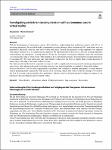Item Infomation
Full metadata record
| DC Field | Value | Language |
|---|---|---|
| dc.contributor.author | Shuaixin Qi, Bsc | - |
| dc.contributor.author | Marino, Menozzi | - |
| dc.date.accessioned | 2023-04-18T01:22:36Z | - |
| dc.date.available | 2023-04-18T01:22:36Z | - |
| dc.date.issued | 2023 | - |
| dc.identifier.uri | https://link.springer.com/article/10.1007/s41449-023-00360-y | - |
| dc.identifier.uri | https://dlib.phenikaa-uni.edu.vn/handle/PNK/8013 | - |
| dc.description | CC BY | vi |
| dc.description.abstract | With the development of autonomous vehicle (AV) technology, understanding how pedestrians interact with AVs is of increasing importance. In most field studies on pedestrian crossing behavior when encountering AVs, pedestrians were not permitted to physically cross the street due to safety restrictions. Instead, the physical crossing experience was replaced with indirect methods (e.g., by signalizing with gestures). We hypothesized that this lack of a physical crossing experience could influence the participants’ crossing behavior. To test this hypothesis, we adapted a reference study and constructed a crossing facility using a virtual reality (VR) simulation. | vi |
| dc.language.iso | en | vi |
| dc.publisher | Springer | vi |
| dc.subject | autonomous vehicle | vi |
| dc.subject | virtual reality | vi |
| dc.title | Investigating pedestrian crossing decision with autonomous cars in virtual reality | vi |
| dc.type | Book | vi |
| Appears in Collections | ||
| OER - Kỹ thuật điện; Điện tử - Viễn thông | ||
Files in This Item:

